STEEMIT CRYPTO ACADEMY SEASON 3 WEEK 8: RISK MANAGEMENT IN TRADING
INTRODUCTION
Hi everyone, welcome to the eighth week of steemit crypto academy season 3. Today I'll be making a post based on the lecture given by professor @yohan2on based on risk management.
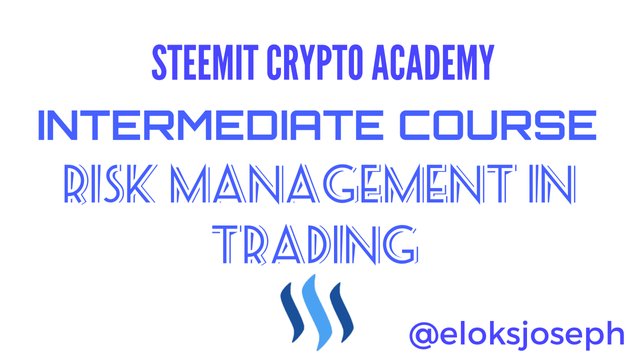

1- Define the following Trading terminologies;
Buy stop
Sell stop
Buy limit
Sell limit
Trailing stop loss
Margin call
(I will also expect an illustration for each of the first 4 terminologies listed above in addition to your explanation)

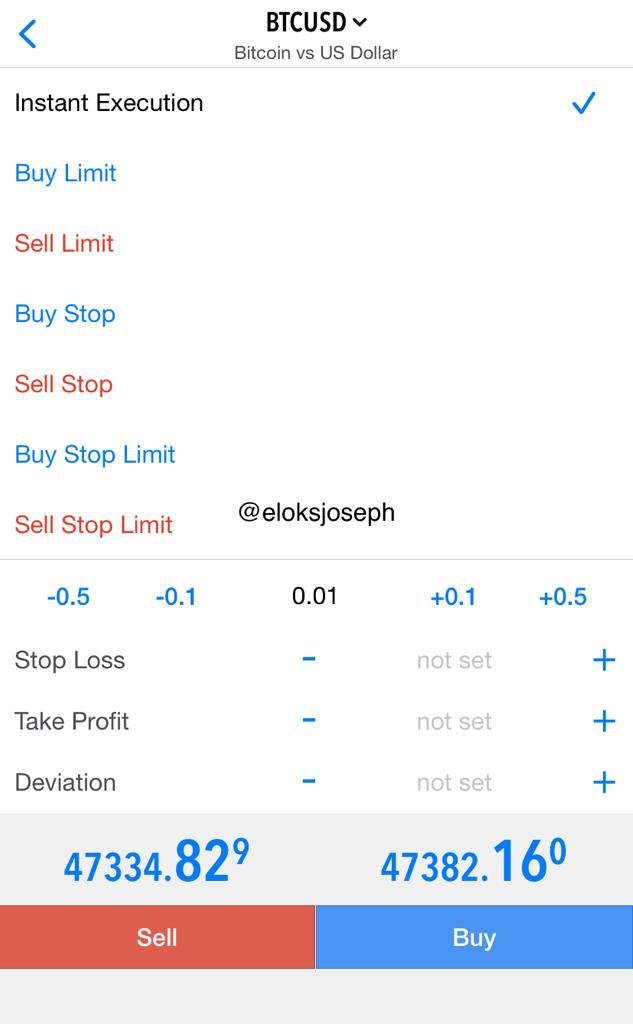
SCREENSHOT FROM METATRADER 5 APP
BUY STOP
A buy stop order is most often made in a market undergoing uptrend. A buy stop order is often placed at a price above the current market price. When this order is placed, it isn't completed instantly. The order is only completed when the price rises up to hit the buy stop price set above the current market price.
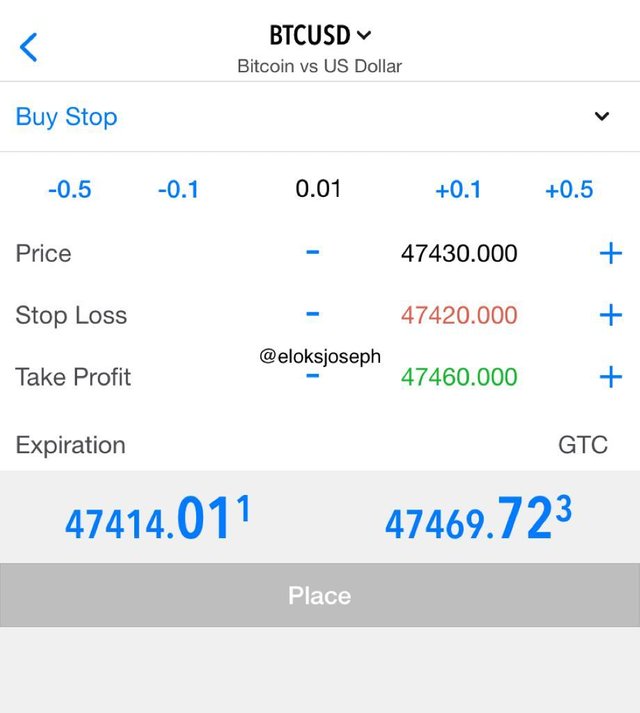
BUY STOP
Screenshot from metatrader 5 app
Let's take an example of an asset currently at $24 ,and a trader sets a buy stop order at $25. The asset won't be bought at that $24 price but it would be placed in the order book until the assets hits the $25 before buying.
Most times , when traders have an asset sold in a shirt position, they often use the buy stop order. Another notable situation where the buy stop order is used is to enter a trade of a market moving in upward in advance.
SELL STOP
This is the opposite of the buy stop order. When entering a trade in the sell position, we enter with the hope that the market keeps falling in a downward movement. The sell stop order is an order set to enter into the trade(sell entry) below the current market price. That means in a downtrending market, the entry is set below the current market price.
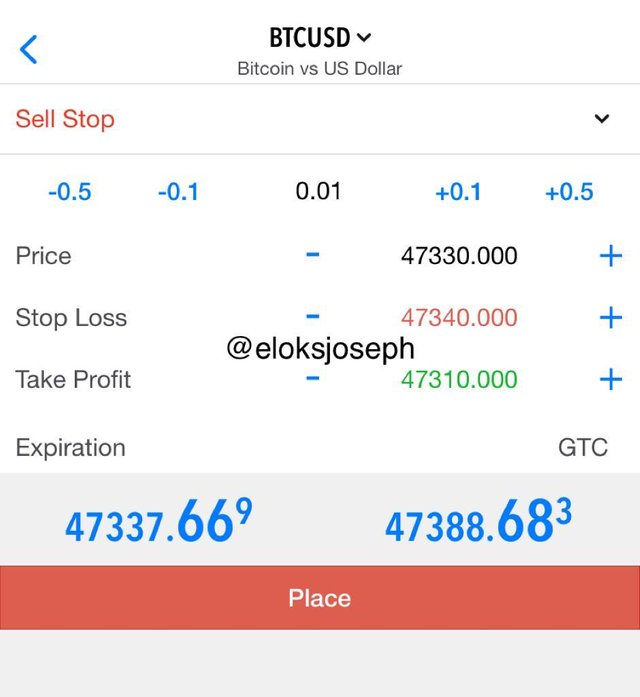
SELL STOP
Screenshot from metatrader 5 app
Taking an example, if an assets price is dropping rapidly and it's current price is about $17 and still dipping , a sell stop order can be set at $17.5 and when the price drops to that point ,the order would be completed.
Sell stop is often used by traders to protect their profit or to reduce the loss on an asset.
BUY LIMIT
In the previous cases where we talked about the buy stop and sell stop where traders create orders in the hope of the market continuing it's current trend, whether downtrend or uptrend. Here, the buy limit deals with entering a trade when the price drops below the current market price.
Most trades use the buy limit with the mindset that the current asset price would drop temporarily before continuing in an uptrend. Let's cite an example. Say I want to buy Cardano (ADA) and I want to use a buy limit. I'll pick a price lower than the current market price and place my order.
One major advantage of the buy limit is that it allows you to set the exact price you want to buy into a trade. If the current price of the asset is higher than your planned buy entry , you can still set it to your initial plan and if it reaches that price, the trade would be put in place and the order completed.
We can see an example of the buy limit being set below.
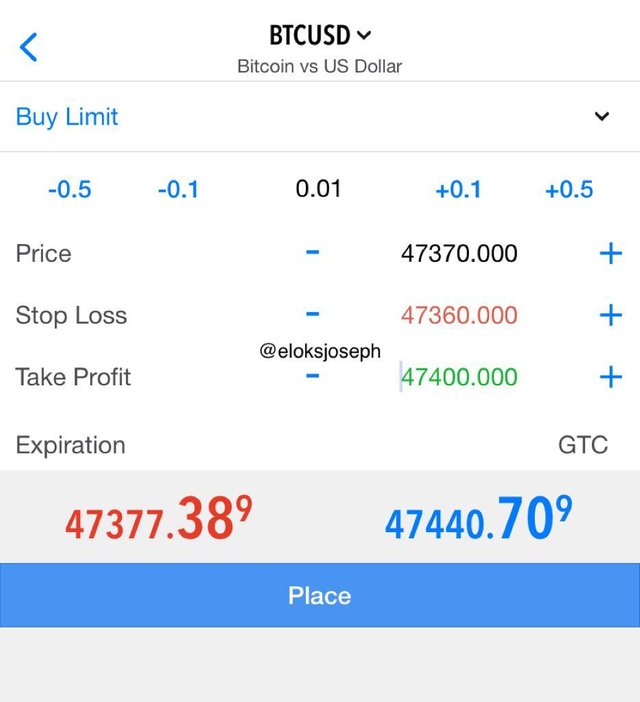
BUY LIMIT
SCREENSHOT FROM METATRADER 5 APP
SELL LIMIT
Now that we understand what the buy limit is all about, let's talk about trading in the opposite position - the sell limit. The sell limit is the opposite of sell stop based in position of price and the opposite of the buy limit based on the market position.
Setting up a sell limit means that (I) you're entering into a trade in the sell position and ; (II) you're setting a price above the current market price to enter the trade . The set limit involves setting up an entry price for yourself above the current market price.
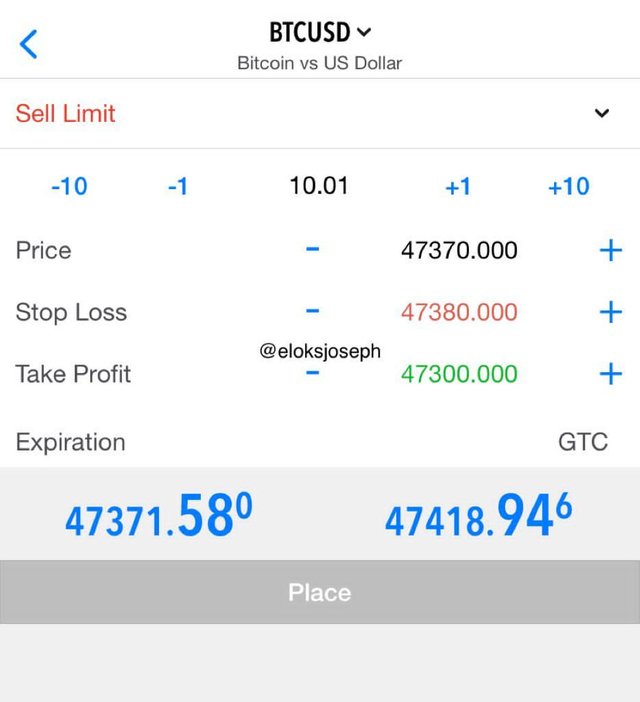
SELL LIMIT
SCREENSHOT FROM METATRADER 5 APP
From the screenshot above you can see how a sell limit trade is usually set up. The sell limit should be above the current market price(market was very volatile when making screenshot), the stop loss above the sell limit and the take profit below the market price.
TRAILING STOP LOSS
As the name implies "trailing" , it means the stop loss is not stationary and it moves. The trailing stop loss works in such a way that the trader is allowed to set a particular percentage from the live market price. Simply put , the percentage the trader set follows the price as long as it is moving favorably.
When a trader enters a trade and uses a trailing stop loss, if the trade moves in the traders favour and the percentage he picked earlier had been crosses , the trailing stop loss locked that profit down and moves the stop loss to that level.
Let's take an example. If a trader enters a trade with a trailing stop loss with $100 and a 5% trailing stop loss, if the market doesn't move in his favor, after a 5% loss($95), the trade would be closed. Now on the other hand, if the market moves in his favor and keeps going and crosses the first 5%($105), a new stop loss would be formed ( $99.75). If it moves favorably on again, and hits the $110 mark , a new stop loss would be made at 5%($104.5). Now,the most admirable thing about the trailing stop loss is that if the market now moves out if favour of the trader, it's the latest stop loss that'll be used. That is , if the market had stopped above the $110 mark and started reversing, it's the new stop loss that'll be required to close the trade.
The trailing stop loss can be used for both buy and sell positions in the market and most traders use it as it protects the gains made by a trader and reduces the amount of loss per trade.
MARGIN CALL
A margin call is sent to a trader when he doesn't have enough funds in his margin account . Now when we say the trader does not have enough funds in his margin account, we dont mean the account is empty. We mean the account is below what is known as the maintenance margin.
The maintenance margin in margin trading the the minimum amount of funds that must be present in a margin account.
When a trader receives a margin call, he had two choices. He can either deposit money or he can sell the assets in his Account. From all these so far we can now say that the margin call is received by traders whose account have gone below the maintenance margin. To respond to a margin call, you'll be required to deposit money into your account.

2 - Practically demonstrate your understanding of Risk management in Trading.
*Briefly talk about Risk management
*Be creative (I will expect some illustrations)
*Use a Moving averages trading strategy on any of the crypto trading charts to demonstrate your understanding of Risk management. (screenshots needed)
RISK MANAGEMENT
Risk management is an important part of trading that is often overlooked by traders. Its importance should be duly recognized as we all try to get profit from our trades, we should also put in place measures to protect out capital in case things don't go as planned.
Traders primarily enter trades to make profit,but sometimes the market reverses and they make losses instead. Luckily, there are things you can do to prevent total loss of your capital. There are many risk management techniques. Let's take a look at some.
STOP LOSS/TAKE PROFIT AND THE RISK: REWARD RATIO
If you're a trader, these terminologies should be common to you as most traders make use of this risk management. The stop loss and take profit often closes trades automatically after they have been reached.
The stop loss is a set price put by the trader in the opposite direction of the trade he or she is making to minimize loses in trade. Simply put, if a trader enters a trade in the buy position, he trades for the market to go up so his stop loss will be set below the market price. On the other hand if a trader enters the trade in the sell position, he wants it to keep going down, so the stop loss should be set above the current market price.
The take profit level is the set price inputed by the trader in the direction of his trade to close the trade automatically when it has made a specific amount of profit. If a trader enters a market in the buy position, his take profit is set in the buy position above the current market price. Similarly, if a trader enters a trade in the sell position, his take profit would be in the sell position below the market price.
Moving on to the risk reward ratio, it is a very simple thing to understand. The risk reward ratio is the relationship between the amount you're willing to risk for a certain amount of profit. Most beginners are often advised to use a ratio of 1:1 . This means that when a trader risks $10, his corresponding reward is to be $10 too.
As we move on In experience and we go on trading over and over,we can then increase our risk reward ratio to bigger levels like the 1:2 (in this case you get twice the amount you risked), 1:3 ( here you get thrice the amount you risk, or even higher levels like the 1:5,1:10 or even as large as 1:50 !!!
The risk reward ratio is really important as it is often used when picking out the stop loss and take profit. For example if an asset is bought at maybe $100 and you want to use a risk reward ratio. If the stop loss is set at maybe $90 dollars, and the take profit at maybe 120$ . Your risk reward ratio is at 1:2 as you have set the take profit to give you twice the amount you're willing to risk.
RISK PER DAY/RISK PER TRADE
As we have established what the take profit, stop loss and the risk reward ratio, let's move in to the risk per trade and risk per day. Your risk is the amount of capital you can afford to lose.
That said , the risk per trade is the amount you're willing to risk for every trade. Meanwhile, the risk per day is the amount of capital can afford to lose per day. It is best to keep the risks at a low especially if you're a beginner to trading. Your risk per trade should not be that high as your total risk per day is the combination of all your risks times the number of trades you made that day.
In simple terms if your capital for the day is $10 and for each trade you use $1 (10 trades) and your risk per trade is maybe 5% , in a day you can afford to lose just about $0.5 (0.05 per trade × 10 trades). This stops you from running through your entire capital in one day.
It should be noted that your risk percentage should be kept very low as maintain longetivity in trading . It is advisable not to go above the 5% mark but it is still the traders choice. Only risk what you can afford to lose.
USING MOVING AVERAGE TO EXPLAIN RISK MANAGEMENT
The moving average indicator is used to know the current trend of a market. Any direction the MA is facing indicates the trend if the market. In the chart below, the MA just changed direction and it is reacting fast with the market price. It shows it is undergoing downtrend.
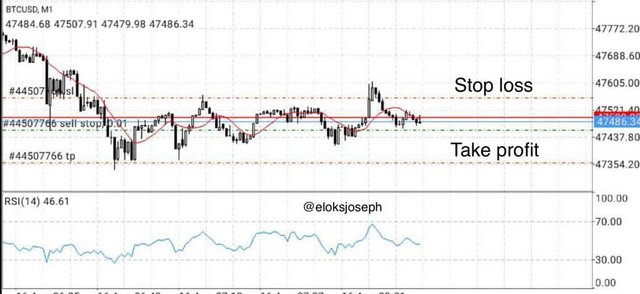
SCREENSHOT FROM METATRADER 4
Since the market is undergoing downtrend and the RSI graph is also 50 region, we can make a sell entry so I shall simulate a sell stop trade.
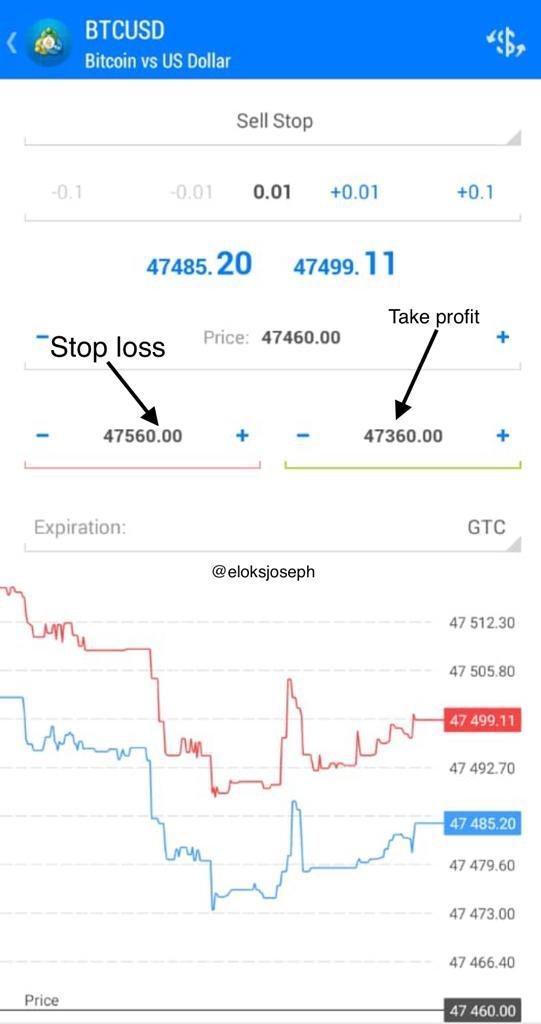
SCREENSHOT FROM METATRADER 4
STOP LOSS: $47560
TAKE PROFIT: $47360
ENTRY PRICE : $47460
From the information given above , we can see that the trade was set in a 1: 1 risk reward ratio for the trade.
From the trade simulated above, I have used the stop loss ,take profit and also the risk reward ratio risk management techniques .

CONCLUSION
Risk management is an important part of trading that is used by traders to prevent excessive loses and in some cases like the trailing stop loss,also used to secure some profit. Traders who often risk management are liable to suffer huge losses as there are no regulations in their trade.
Thank you or the lecture professor @yohan2on .
Hi @eloksjoseph
Thanks for participating in the Steemit Crypto Academy
Feedback
This is good content though you needed to illustrate the Buy stop, sell stop, Buy limit and Sell limit on the chart. What you provided was not well convincing. Otherwise thanks for your effort.
Thank you for your review sir